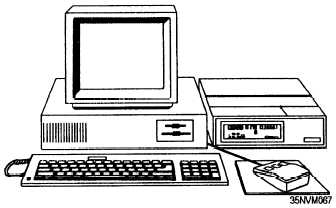l Large to medium rugged frame or cabinet —
Some frames or cabinets use a stationary or sliding
chassis or assemblies or stationary racks or card cages
that contain individual modules or printed circuit
boards. The functional and support areas include a
central processor unit (CPU), memory units,
input/output controller boards for various peripherals,
I/O connectors, power supply unit(s), and blower
motors for cooling.
(NOTE: Some minicomputer
frames or cabinets also contain the peripherals-disk
drive units, magnetic tape units, and paper tape units.)
. Control and Maintenance Panel (CMP) or
computer control panel —Controls operation of the
computer and is used to perform maintenance
(preventive and corrective).
l Specific power requirements (frequency and
voltage).
l Specific cooling requirements (air and/or liquid
cooling).
Microcomputers
Microcomputers, personal computers (PCs), are
small, lightweight, and portable. Some of them are
more powerful than some of the older, larger
mainframes and minicomputers. Microcomputers are
unique in that the heart of the computer (the CPU) is
contained on a single integrated chip (IC) and the entire
computer system is contained on a handful of printed
circuit boards located inside a small compact frame or
cabinet. In some cases a complete microcomputer is
located on a single chip; the CPU, co-processor, and
memory. Some micros/PCs are high-speed, multi-user,
multi-tasking units. Traditionally micros are used for
word processing, database management, spreadsheets,
graphics, desktop publishing, and other general office
applications. Currently, micros and PCs are being
used for tactical support systems, such as Naval
Intelligence Processing Systems (NIPS) and Joint
Operational Tactical System (JOTS). Micros and PCs
can also be used as a SNAP system for shorebased
operational commands, such as ASWOC. The
operational programs for PCs used for a tactical
support system are supported externally by technical
teams. These operational programs are also updated as
systems are added or replaced. Programs that are used
for word processing, graphics, and so on are abundant
and can be obtained through civilian vendors and
software support teams such as Commander Naval
Computer and Telecommunications Command
(COMNAVCOMTELCOM). Training for micro-
computers is obtained through formal A schools,
civilian contractor schools, and OJT. Training for
micros is not NEC producing. Figure 1-5 is an
illustration of a typical microcomputer.
The physical features of microcomputers are very
different from mainframes and minis. The following is
a brief description of a typical PC/desktop system.
l Small compact frame or cabinet —PCs are uni-
que in that the frame or cabinet contains the majority of
the components for a complete system. A typical PC
frame or cabinet contains the following components:
Backplane or motherboard for printed circuit
boards
A central processor unit (CPU) and memory
printed circuit board(s) (pcb) (NOTE: In
some cases the CPU and memory are located
on the same pcb.)
Input/output pcb
Disk controller pcb
Video controller pcb
Data storage devices: Hard disk drive units,
floppy disk drive units, and/or tape cassette
units
I/O connector: Parallel or serial communica-
tions
A small fan: No special cooling require-
ments; the unit relies on ambient temperature
of the room or space
Power supply: No special requirements
Display monitors are output
l Display monitor —
devices for visual displays of data, and may have
monochrome or color displays.
Figure 1-5.—Example of a microcomputer.
1-6


